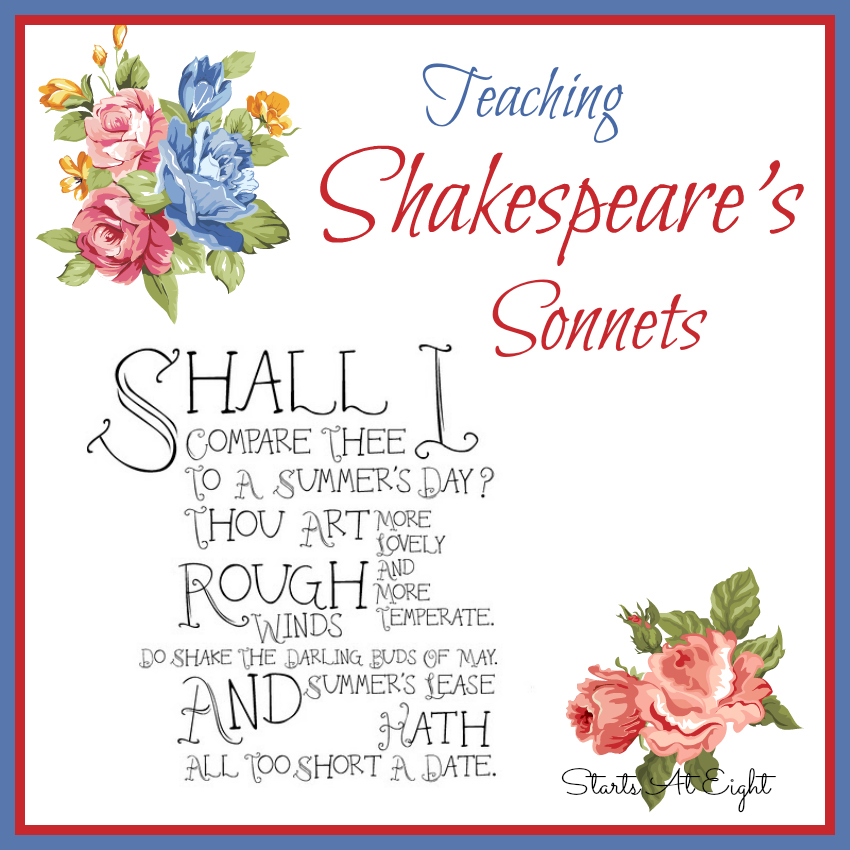Teaching Shakespeare Sonnets
So what exactly is a sonnet anyways? A sonnet is a 14-line poem with a variable rhyme scheme originating in Italy and brought to England by Sir Thomas Wyatt and Henry Howard, earl of Surrey in the 16th century. Literally a “little song,” the sonnet traditionally reflects upon a single sentiment, with a clarification or “turn” of thought in its concluding lines. Learning about sonnets can be a fun activity and a great lead in to understanding Shakespeare Sonnets.

About Sonnets
A sonnet is simply a poem written in a certain format. You can identify a sonnet if the poem has the following characteristics:
- 14 lines. All sonnets have 14 lines which can be broken down into four sections called quatrains.
- A strict rhyme scheme. The rhyme scheme of a Shakespearean sonnet is ABAB / CDCD / EFEF / GG (note the four distinct sections in the rhyme scheme).
- Written in iambic Pentameter. Sonnets are written in iambic pentameter, a poetic meter with 10 beats per line made up of alternating unstressed and stressed syllables.
Use this First Shakespeare Lesson Plan to work out this activity and then move beyond with other readings and activities to get your children started with the rhythm of Shakespeare’s verse.
A sonnet can be broken down into four sections called quatrains. The first three quatrains contain four lines each and use an alternating rhyme scheme. The final quatrain consists of just two lines which both rhyme.
There are 154 Shakespearean Sonnets. Rather than list them all I have linked to Shakespeare Facts which has a complete numbered list as well as each complete sonnet.
Teaching Shakespeare Sonnets
- Easing into Shakespeare with a Modern Sonnet – Modern sonnets can be more accessible than Shakespeare’s to most students, and one of Millay’s can be a good introduction to both a classic form of the sonnet and to one of its most recurrent and popular themes, lost love. Examining her techniques prepares the way for reading sonnets by writers of the past.
- Understanding the Sonnet – Better understand sonnets using this worksheet on one of Shakespeare’s works. Students will read through “Sonnet 130” by William Shakespeare, determine the rhyme scheme, and answer questions about the passage using what they’ve learned.
- Close Reading Shakespeare Sonnets – Students will analyze the sonnets for diction, syntax, literary devices, and rhetorical strategies and complete a close reading of the sonnets.
- Printable Shakespeare Sonnet Worksheet (Romeo & Juliet)
- Compare/Contrast 2 Shakespeare Sonnets – #18 & #130 with worksheet
- Lesson and Quiz on Sonnet #18
- Lesson & Quiz on Sonnet #130
- Read & Answer Questions about Specific Shakespeare Sonnets – A printable worksheet with questions on Sonnets 29, 73, 116, and 130.
High School Shakespeare Series
In this High School Shakespeare series I will be covering each one of these topics and linking to them below.
Day One: Introduction and Overview
Day Two: Why Teach Shakespeare?
Day Three: Shakespeare’s Sonnets (this post)
Day Four: Romeo & Juliet
Day Five: Studying Shakespeare’s Hamlet
Bonus: A Mid Summer Night’s Dream




October 11, 2016 @ 1:14 pm
My oldest son memorized a sonnet when he was little because I would quote it to him so much. I’ve always loved Shakespeare. I had my kids re-enact many scenes from Shakespeare plays to that they could internalize the plot of the story, and they had a ball!
October 11, 2016 @ 4:30 pm
I wish my kids were into theater! Re-enacting Shakespeare might make it more fun for them but none of them will even try. 🙁